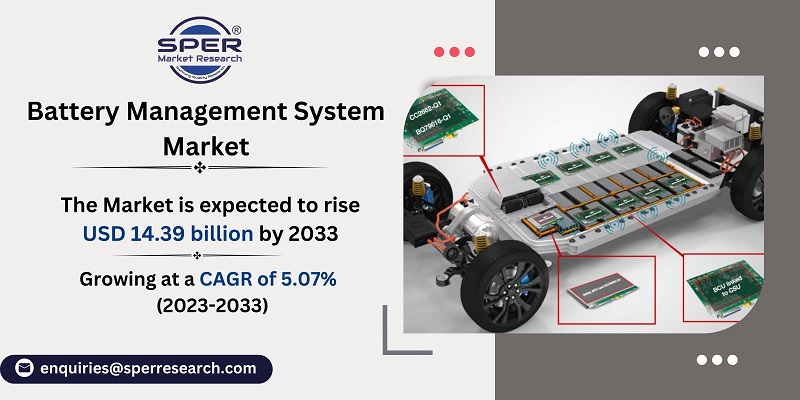
Battery Management System Market Growth, Trends, Size, Revenue, Demand and Future Outlook
Battery Management System Market Size- By Battery, By Topology, By Application, By End-Use Industry- Regional Outlook, Competitive Strategies and Segment Forecast to 2033
| Published: Sep-2023 | Report ID: POAE2358 | Pages: 1 - 328 | Formats*: |
| Category : Power & Energy | |||
- July 2022: Volkswagen made plans to invest over USD 20 billion in Power Co, a new German company that will make EV batteries. The factory will likely be able to handle the demand for up to 500,000 EVs in the upcoming years once manufacturing begins in 2025.
- May 2022: A significant global carmaker made the decision to employ BorgWarner's battery management system (BMS) for all of its B-, C-, and light commercial vehicle platforms. Beginning in mid-2023, the new BorgWarner BMS technology is predicted to optimise the performance, security, and longevity of battery packs.

- Opportunities:
Adoption of electric and hybrid cars (EVs) at a faster rateGlobally, governments have put into place strict laws and guidelines like the Kyoto Protocol to cut back on greenhouse gas (GHG) emissions. Additionally, the automotive industry has innovated with the development of electric and hybrid vehicles as a result of growing public awareness of the damaging environmental consequences of vehicles powered by gasoline and diesel.
Industrial inclination for using lithium-ion batteries has increased
In applications including electric vehicles, consumer electronics, and renewable energy storage systems, BMS systems are crucial for regulating and optimizing lithium-ion battery performance, safety, and longevity. In order to prevent issues like thermal runaway, BMS systems keep an eye on the temperature and voltage of each cell, adjust charging and discharging procedures, balance charge levels, and provide safety features like overvoltage and overcurrent shielding.
- Challenges:
An increase in the product's overall cost due to the inclusion of a battery management systemOne of the main barriers to the market for battery management systems (BMS) is the increase in overall cost of a product when a BMS is added.

| Report Metric | Details |
| Market size available for years | 2019-2033 |
| Base year considered | 2022 |
| Forecast period | 2023-2033 |
| Segments covered | By Battery, By Topology, By Application, By End-Use Industry |
| Regions covered | North America, Asia-Pacific, Latin America, Middle East & Africa and Europe |
| Companies Covered | Analog Devices, Eberspacher, Elithion Inc., Johnson Matthey, Leclanche SA, Marelli Holdings Co., Ltd, Navitas System, LLC, Nidec Motor Corporation, Nuvation Energy, Panasonic Industry Co., Ltd, Sedemac, Texas Instruments, Toshiba Electronic Devices & Storage Corporation, Others |
- Battery Manufacturers
- Battery Recycling and Environmental Organizations
- Battery Testing and Certification Services
- Electric Vehicle (EV) Manufacturers
- Electronics and Consumer Goods Manufacturers
- Energy Storage System (ESS) Manufacturers
- Fleet Operators
- Maritime Industry
- Renewable Energy Companies
- Telecommunications Industry
- Others
| By Battery: |
|
| By Topology: |
|
| By Application: |
|
| By End-Use Industry: |
|
- Global Battery Management System Market Size (FY’2023-FY’2033)
- Overview of Global Battery Management System Market
- Segmentation of Global Battery Management System Market By Battery (Flow Battery, Lead-Acid, Lithium-ion, Nickel)
- Segmentation of Global Battery Management System Market By Topology (Centralized, Distributed, Modular)
- Segmentation of Global Battery Management System Market By Application (Computing Devices, Electric Vehicles, Industrial Systems, Personal Mobility Instruments, Renewable Energy Systems, UPS, Others)
- Segmentation of Global Battery Management System Market By End-Use Industry (Automotive & Transportation, Consumer Electronics, Energy & Utility, Healthcare, Military & Defense, Others)
- Statistical Snap of Global Battery Management System Market
- Expansion Analysis of Global Battery Management System Market
- Problems and Obstacles in Global Battery Management System Market
- Competitive Landscape in the Global Battery Management System Market
- Impact of COVID-19 and Demonetization on Global Battery Management System Market
- Details on Current Investment in Global Battery Management System Market
- Competitive Analysis of Global Battery Management System Market
- Prominent Players in the Global Battery Management System Market
- SWOT Analysis of Global Battery Management System Market
- Global Battery Management System Market Future Outlook and Projections (FY’2023-FY’2033)
- Recommendations from Analyst
1.1. Scope of the report1.2. Market segment analysis
2.1. Research data source2.1.1. Secondary Data2.1.2. Primary Data2.1.3. SPER’s internal database2.1.4. Premium insight from KOL’s2.2. Market size estimation2.2.1. Top-down and Bottom-up approach2.3. Data triangulation
4.1. Driver, Restraint, Opportunity and Challenges analysis4.1.1. Drivers4.1.2. Restraints4.1.3. Opportunities4.1.4. Challenges4.2. COVID-19 Impacts of the Global Battery Management System Market
5.1. SWOT Analysis5.1.1. Strengths5.1.2. Weaknesses5.1.3. Opportunities5.1.4. Threats5.2. PESTEL Analysis5.2.1. Political Landscape5.2.2. Economic Landscape5.2.3. Social Landscape5.2.4. Technological Landscape5.2.5. Environmental Landscape5.2.6. Legal Landscape5.3. PORTER’s Five Forces5.3.1. Bargaining power of suppliers5.3.2. Bargaining power of buyers5.3.3. Threat of Substitute5.3.4. Threat of new entrant5.3.5. Competitive rivalry5.4. Heat Map Analysis
6.1. Global Battery Management System Market Manufacturing Base Distribution, Sales Area, Product Type6.2. Mergers & Acquisitions, Partnerships, Product Launch, and Collaboration in Global Battery Management System Market
7.1. Global Battery Management System Market Value Share and Forecast, By Battery, 2023-20337.2. Flow Battery7.3. Lead-Acid7.4. Lithium-ion7.5. Nickel
8.1. Global Battery Management System Market Value Share and Forecast, By Topology, 2023-20338.2. Centralized8.3. Distributed8.4. Modular
9.1. Global Battery Management System Market Value Share and Forecast, By Application, 2023-20339.2. Computing Devices9.3. Electric Vehicles9.4. Industrial Systems9.5. Personal Mobility Instruments9.6. Renewable Energy Systems9.7. UPS (Uninterrupted Power Supply)9.8. Others
10.1. Global Battery Management System Market Value Share and Forecast, By End-Use Industry, 2023-203310.2. Automotive & Transportation10.3. Consumer Electronics10.4. Energy & Utility10.5. Healthcare10.6. Military & Defense10.7. Others
11.1. Global Battery Management System Market Size and Market Share
12.1. Global Battery Management System Market Size and Market Share By Battery (2019-2026)12.2. Global Battery Management System Market Size and Market Share By Battery (2027-2033)
13.1. Global Battery Management System Market Size and Market Share By Topology (2019-2026)13.2. Global Battery Management System Market Size and Market Share By Topology (2027-2033)
14.1. Global Battery Management System Market Size and Market Share By Application (2019-2026)14.2. Global Battery Management System Market Size and Market Share By Application (2027-2033)
15.1. Global Battery Management System Market Size and Market Share By End-Use Industry (2019-2026)15.2. Global Battery Management System Market Size and Market Share By End-Use Industry (2027-2033)
16.1. Global Battery Management System Market Size and Market Share By Region (2019-2026)16.2. Global Battery Management System Market Size and Market Share By Region (2027-2033)16.3. Asia-Pacific16.3.1. Australia16.3.2. China16.3.3. India16.3.4. Japan16.3.5. South Korea16.3.6. Rest of Asia-Pacific16.4. Europe16.4.1. France16.4.2. Germany16.4.3. Italy16.4.4. Spain16.4.5. United Kingdom16.4.6. Rest of Europe16.5. Middle East and Africa16.5.1. Kingdom of Saudi Arabia16.5.2. United Arab Emirates16.5.3. Rest of Middle East & Africa16.6. North America16.6.1. Canada16.6.2. Mexico16.6.3. United States16.7. Latin America16.7.1. Argentina16.7.2. Brazil16.7.3. Rest of Latin America
17.1. Analog Devices17.1.1. Company details17.1.2. Financial outlook17.1.3. Product summary17.1.4. Recent developments17.2. Eberspacher17.2.1. Company details17.2.2. Financial outlook17.2.3. Product summary17.2.4. Recent developments17.3. Elithion Inc.17.3.1. Company details17.3.2. Financial outlook17.3.3. Product summary17.3.4. Recent developments17.4. Johnson Matthey17.4.1. Company details17.4.2. Financial outlook17.4.3. Product summary17.4.4. Recent developments17.5. Leclanche SA17.5.1. Company details17.5.2. Financial outlook17.5.3. Product summary17.5.4. Recent developments17.6. Marelli Holdings Co., Ltd17.6.1. Company details17.6.2. Financial outlook17.6.3. Product summary17.6.4. Recent developments17.7. Navitas System, LLC17.7.1. Company details17.7.2. Financial outlook17.7.3. Product summary17.7.4. Recent developments17.8. Nidec Motor Corporation17.8.1. Company details17.8.2. Financial outlook17.8.3. Product summary17.8.4. Recent developments17.9. Nuvation Energy17.9.1. Company details17.9.2. Financial outlook17.9.3. Product summary17.9.4. Recent developments17.10. Panasonic Industry Co., Ltd17.10.1. Company details17.10.2. Financial outlook17.10.3. Product summary17.10.4. Recent developments17.11. Sedemac17.11.1. Company details17.11.2. Financial outlook17.11.3. Product summary17.11.4. Recent developments17.12. Texas Instruments17.12.1. Company details17.12.2. Financial outlook17.12.3. Product summary17.12.4. Recent developments17.13. Toshiba Electronic Devices & Storage Corporation17.13.1. Company details17.13.2. Financial outlook17.13.3. Product summary17.13.4. Recent developments17.14. Others
SPER Market Research’s methodology uses great emphasis on primary research to ensure that the market intelligence insights are up to date, reliable and accurate. Primary interviews are done with players involved in each phase of a supply chain to analyze the market forecasting. The secondary research method is used to help you fully understand how the future markets and the spending patterns look likes.
The report is based on in-depth qualitative and quantitative analysis of the Product Market. The quantitative analysis involves the application of various projection and sampling techniques. The qualitative analysis involves primary interviews, surveys, and vendor briefings. The data gathered as a result of these processes are validated through experts opinion. Our research methodology entails an ideal mixture of primary and secondary initiatives.



Frequently Asked Questions About This Report
PLACE AN ORDER
Year End Discount
Sample Report
Pre-Purchase Inquiry
NEED CUSTOMIZATION?
Request CustomizationCALL OR EMAIL US
100% Secure Payment






Related Reports
Our Global Clients
Our data-driven insights have influenced the strategy of 200+ reputed companies across the globe.




















